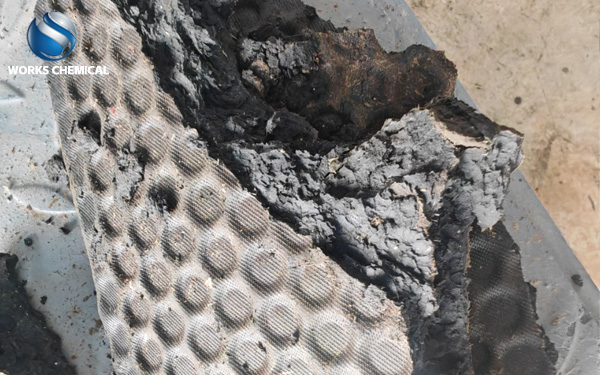
In the field of sludge treatment, the plate and frame filter press, as the core solid-liquid separation equipment, its efficiency directly determines the cost of sludge disposal and the potential for resource utilization. The emergence of sludge efficiency enhancers, through the synergistic effect of chemical modification and physical pressing, has endowed plate and frame filter presses with new technological vitality and has become a key technology promoting the transformation and upgrading of the sludge treatment industry.

I. Technical Principle: Chemical modification breaks through the bottleneck of sludge dewatering
The core mechanism of action of sludge enhancers lies in the targeted destruction of the colloid structure of sludge. The microbial cell walls, extracellular polymers (EPS) and organic matter in the sludge form a stable colloidal network, which wraps a large amount of interstitial water and bound water, resulting in the low efficiency of traditional mechanical dewatering. Sludge enhancers achieve deep dewatering through the synergistic action of multiple components:
Cell wall disruptors and surface modifiers: They decompose the cell walls of microorganisms, release intracellular water, and simultaneously reduce the surface charge of sludge particles, thereby disrupting the stability of colloids.
Flocculation and framework construction: Through the bridging effect between inorganic compounds and high-molecular polymers, large and dense flocs are formed to build a "framework" that supports the structure of the sludge, preventing the clogging of filter holes during high-pressure pressing.
Hydrophobic modification: The sludge surface treatment agent forms a hydrophobic layer on the particle surface, accelerating water removal and enhancing the permeability of the filtrate.
Sludge enhancers can reduce the moisture content of sludge from over 90% to 40%-60%, significantly reducing the volume of sludge. Experimental data show that after adding the enhancer, the specific surface area of the sludge decreased by more than 60%, and the solid surface load dropped by 50%, creating conditions for subsequent high-pressure pressing.
Ii. Synergy Effect: A qualitative improvement in the efficiency of plate and frame filter presses
The plate and frame filter press achieves solid-liquid separation through high-pressure extrusion. However, the traditional process faces two major pain points: one is that the poor fluidity of sludge makes feeding difficult, and the other is that the moisture content of the filter cake remains high. The application of sludge efficiency enhancers solves problems from two dimensions: process optimization and performance improvement.
Feed efficiency revolution
The sludge enhancer improves the fluidity of the sludge, reducing the load of the feed pump by 30% to 50% and shortening the feed time to one-third of the original. For instance, a sludge treatment project of a certain paper mill demonstrated that after applying the sludge efficiency enhancer, the single-cycle feed rate of the plate and frame filter press increased by 200%, and the equipment utilization rate significantly improved.
Breakthrough in pressing efficiency
At the 1.0MPa low-pressure feeding stage, the sludge enhancer has released 60%-70% of the interstitial water. Entering the high-pressure pressing stage (3-5 mpa), the remaining bound water is efficiently removed. Data shows that the plate and frame filter press that combines the use of sludge enhancers has reduced the pressing cycle by more than 50% and increased the processing capacity by 100% to 500%.
The service life of the filter cloth is prolonged
In traditional processes, chemicals such as lime are prone to crystallization and clogging the filter cloth, requiring frequent cleaning and replacement. The sludge enhancer is non-corrosive. The frequency of reverse blowing and washing of the filter cloth is reduced by 80%, and the service life is extended by 2 to 3 times.
Iii. Economic and Environmental Benefits: Industry Transformation Driven by Dual Wheels
Cost optimization
Take a sewage treatment plant with a daily processing capacity of 100 tons of sludge (with a moisture content of 80%) as an example:
Chemical cost: The dosage of sludge enhancer is 3%-5% of that of absolute dry sludge, and the treatment cost per ton is 40% lower than that of the lime method.
Energy conservation: The pressing cycle is shortened by 50%, and the power consumption per ton of sludge is reduced from 15kWh to 8kWh.
Disposal costs have decreased: The volume of sludge has been reduced by 60%, and transportation and landfill costs have dropped by more than 50%.
Breakthrough in resource utilization
After dewatering, the calorific value of the sludge increases by 30% and can be directly used for incineration power generation or brick-making. The practice of a certain power plant shows that the co-firing ratio of sludge with a moisture content of 60% has been increased from 10% to 25%, saving over 10,000 tons of standard coal annually.
Environmental protection benefits
To avoid pH pollution caused by the use of lime, the concentration of heavy metals in the filtrate decreased by 70%, meeting the requirements of Grade A of the "Discharge Standard of Pollutants for Municipal Wastewater Treatment Plants" (GB 18918).